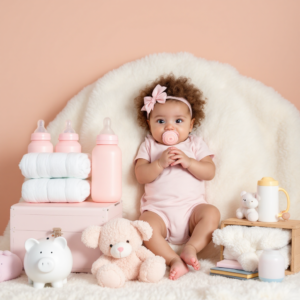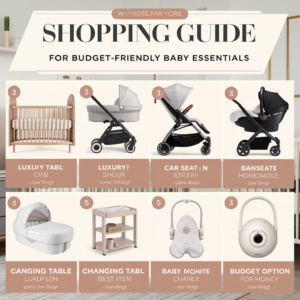A babygirl budget is a comprehensive financial plan specifically designed for parents expecting or raising a baby girl. It encompasses all aspects of financial planning related to the care, upbringing, and future needs of a baby girl, from essential daily items to long-term savings goals.
Key Takeaways:
- A well-structured babygirl budget helps manage expenses and reduce financial stress
- Prioritizing needs over wants is crucial for effective budgeting
- Long-term planning can lead to significant savings
- Flexibility in budgeting is important as baby’s needs change rapidly
- Utilizing resources like secondhand items and sales can stretch your budget further
Understanding the Importance of a Babygirl Budget
A babygirl budget is more than just a financial plan; it’s a tool that helps new parents provide for their daughter while maintaining financial stability. It allows for better allocation of resources and helps prevent overspending on non-essential items. By creating a detailed budget, parents can ensure they’re prepared for both expected and unexpected expenses associated with raising a baby girl.
Step-by-Step Guide to Creating a Babygirl Budget
1. Assess Your Current Financial Situation (Before baby arrives)
- Review your income and existing expenses
- Identify areas where you can cut back to accommodate baby expenses
- Calculate how much you can realistically allocate to baby-related costs
2. Research Essential Costs (2-3 months before due date)
- Make a list of necessary items (crib, car seat, stroller, etc.)
- Research average costs for these items
- Include ongoing expenses like diapers, formula, and healthcare
3. Prioritize Expenses (1-2 months before due date)
- Categorize items as “must-haves,” “nice-to-haves,” and “luxuries”
- Focus your budget on essential items first
- Consider which items can be purchased secondhand or borrowed
4. Create a Savings Plan (As soon as possible)
- Start setting aside money for big-ticket items
- Consider opening a dedicated savings account for baby expenses
- Look into options for automated savings contributions
5. Plan for Healthcare Costs (During pregnancy)
- Review your health insurance coverage
- Estimate out-of-pocket expenses for prenatal care and delivery
- Research costs for pediatric care and vaccinations
6. Consider Childcare Expenses (3-4 months before returning to work)
- Research different childcare options and their costs
- Factor in potential changes to your work schedule or income
- Look into employer benefits or flexible spending accounts for childcare
7. Budget for Clothing and Gear (Ongoing)
- Plan for rapid growth in the first year
- Consider seasonal needs when budgeting for clothing
- Look for adaptable gear that can grow with your baby
8. Plan for Food Costs (First 6 months)
- Budget for breastfeeding supplies or formula
- Plan for the introduction of solid foods around 6 months
- Consider making homemade baby food to save money
9. Factor in One-Time Costs (Before baby arrives)
- Include expenses like nursery furniture and baby-proofing supplies
- Don’t forget about often-overlooked items like a breast pump or diaper bag
- Consider creating a baby registry to offset some of these costs
10. Build in a Buffer (Ongoing)
- Add a “miscellaneous” category to your budget for unexpected expenses
- Aim to set aside 10-15% of your baby budget for unforeseen costs
- Regularly review and adjust this buffer as needed
11. Use Technology to Your Advantage (Ongoing)
- Utilize budgeting apps to track baby-related expenses
- Set up price alerts for big-ticket items you need to purchase
- Use cashback apps or credit cards for additional savings on purchases
12. Review and Adjust Regularly (Monthly)
- Set a monthly date to review your babygirl budget
- Adjust allocations based on changing needs and actual expenses
- Look for areas where you can cut back or where you might need to increase spending
Innovative Budgeting Ideas for 2025
- Use AI-powered apps to predict future expenses based on your baby’s growth patterns
- Join virtual parent groups for shared bulk-buying opportunities
- Utilize augmented reality apps to “try before you buy” baby gear and furniture
- Engage with blockchain-based baby item exchange platforms for secure swapping
- Explore subscription services for regularly needed items like diapers and wipes
Categories to Include in Your Babygirl Budget
Essentials:
- Diapers and wipes
- Formula or breastfeeding supplies
- Basic clothing (onesies, sleepers, socks)
- Feeding supplies (bottles, bibs, burp cloths)
Healthcare:
- Insurance copays and deductibles
- Over-the-counter medications
- Baby-specific health items (thermometer, nasal aspirator)
Gear:
- Car seat
- Stroller
- Crib or bassinet
- Baby carrier or wrap
Miscellaneous:
- Toiletries (baby wash, lotion, diaper cream)
- Safety items (baby gates, outlet covers)
- Toys and books for development
Long-term Savings:
- Education fund
- Emergency fund for unexpected baby expenses
Frequently Asked Questions
Q: How much should I budget for a newborn baby girl? A: While costs can vary widely, plan for an average of $10,000-$12,000 for the first year, including one-time purchases.
Q: Is it worth buying designer clothes for my baby girl? A: Generally, it’s not necessary. Babies grow quickly, and functional, comfortable clothing is more important than brand names.
Q: How can I save money on diapers? A: Consider cloth diapers, buy in bulk, use diaper subscription services, or look for sales and coupons on disposable diapers.
Q: Should I buy all baby items before birth? A: Purchase essentials before birth, but wait on some items. You may receive gifts or find you don’t need everything you initially thought.
Q: How do I budget for unexpected baby expenses? A: Include a buffer in your budget, start an emergency fund specifically for baby expenses, and be prepared to adjust your budget as needed.
Conclusion
Creating a babygirl budget is an essential step in preparing for your new arrival. By carefully planning and prioritizing expenses, you can ensure that you’re financially prepared to provide for your daughter without unnecessary stress. Remember that every family’s needs and resources are different, so your budget should be personalized to your situation. Stay flexible and be prepared to adjust your budget as your baby grows and her needs change. With careful planning and smart spending, you can give your babygirl everything she needs while maintaining financial stability. Remember, the most important things you can give your child – love, attention, and care – don’t cost a thing.



